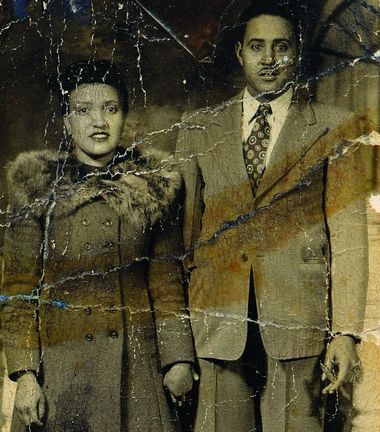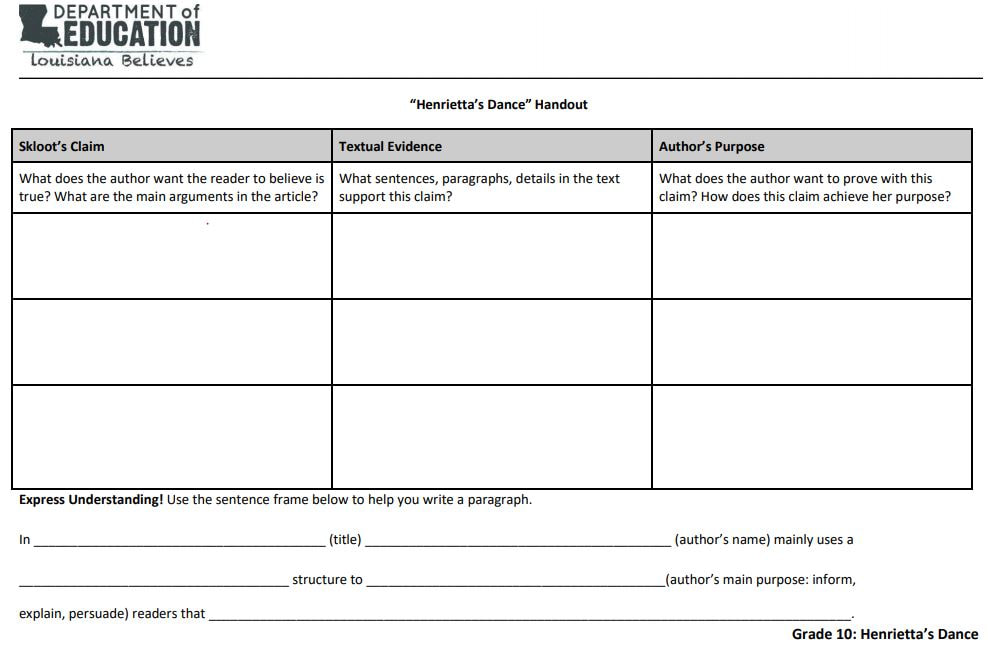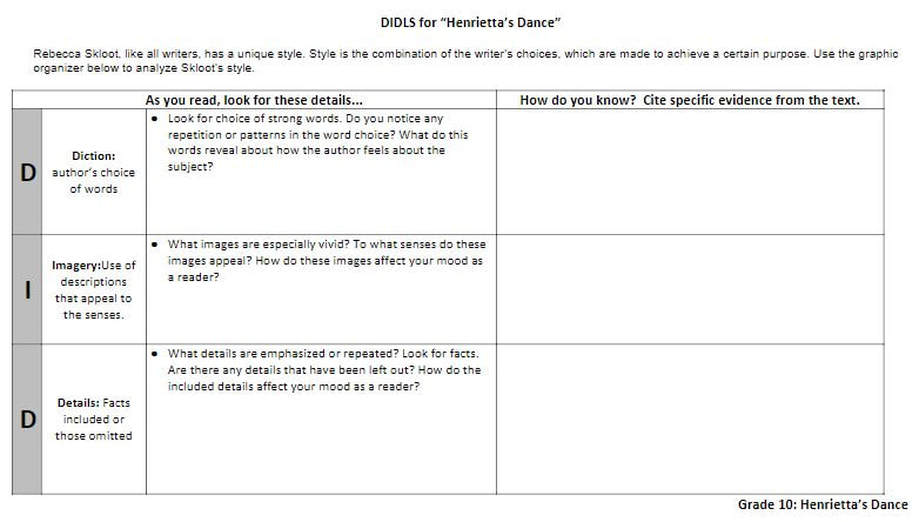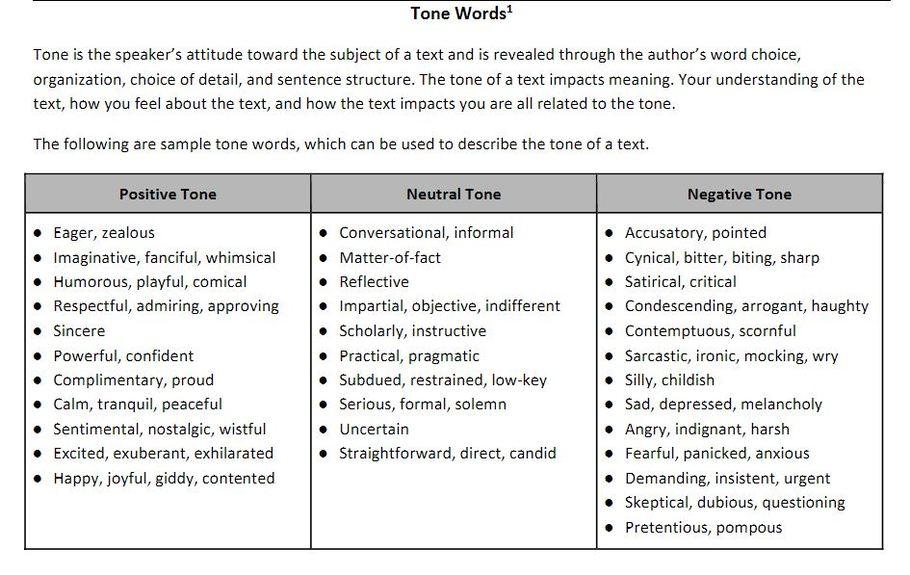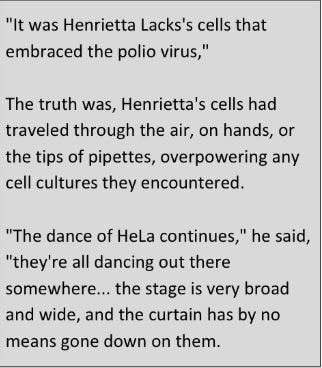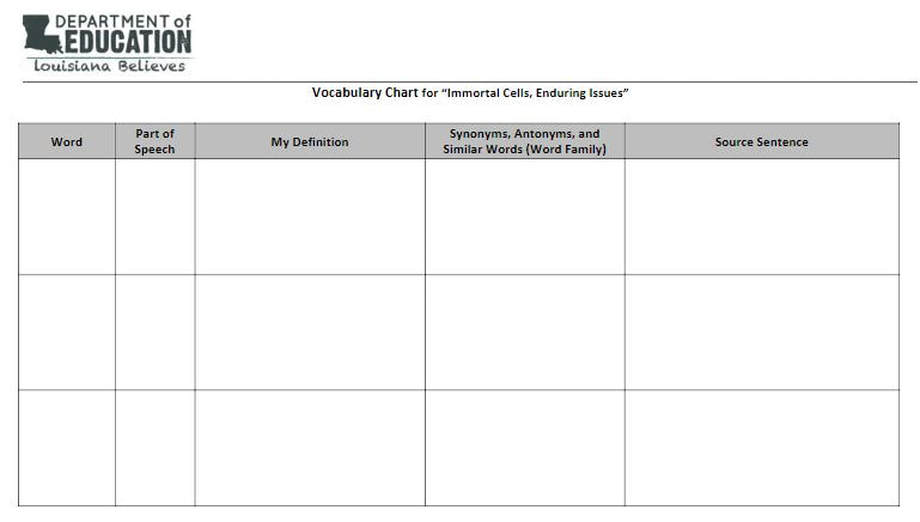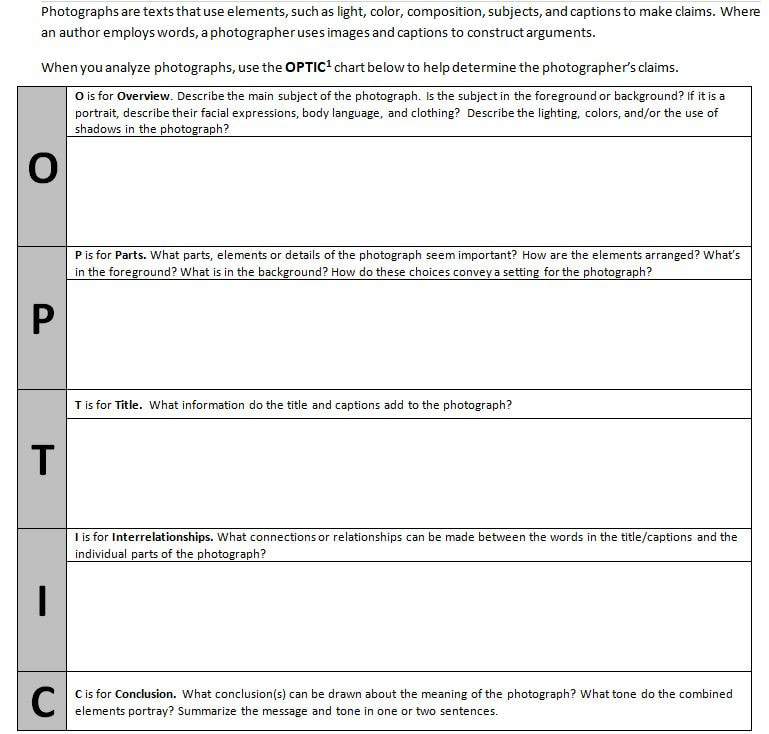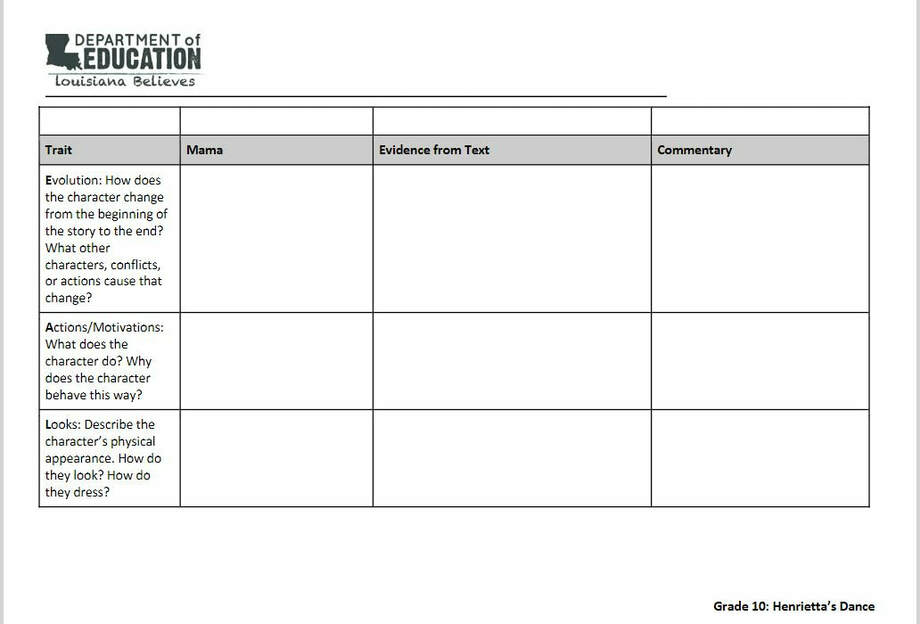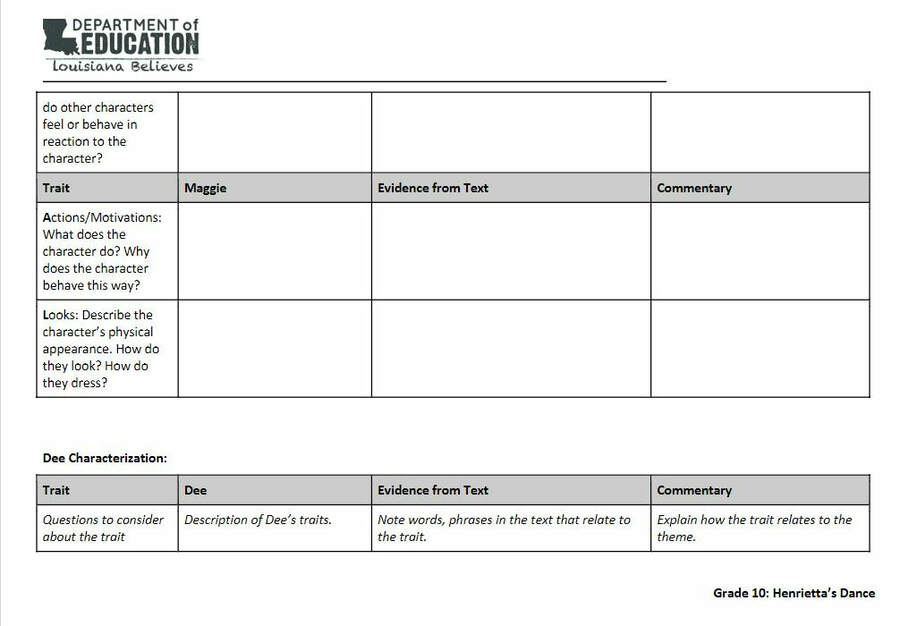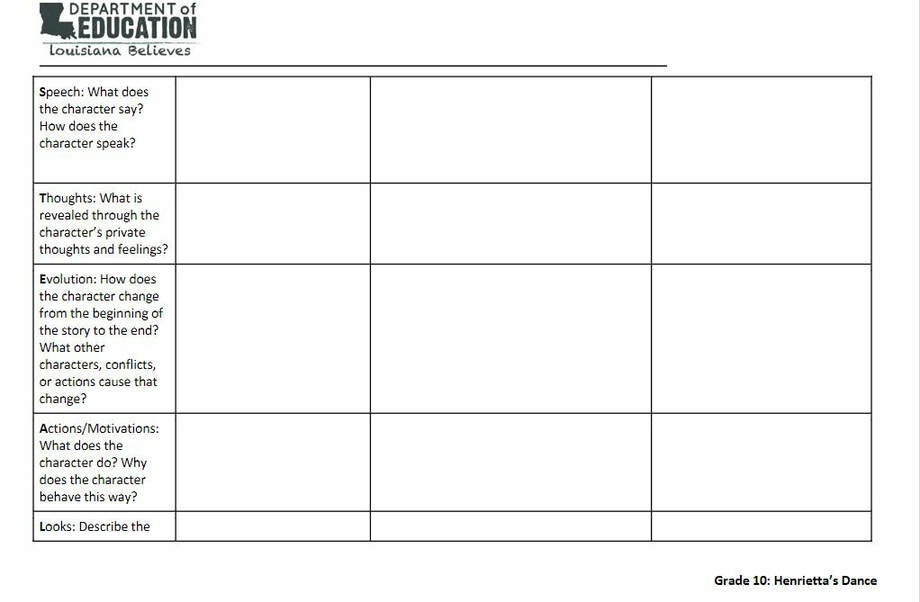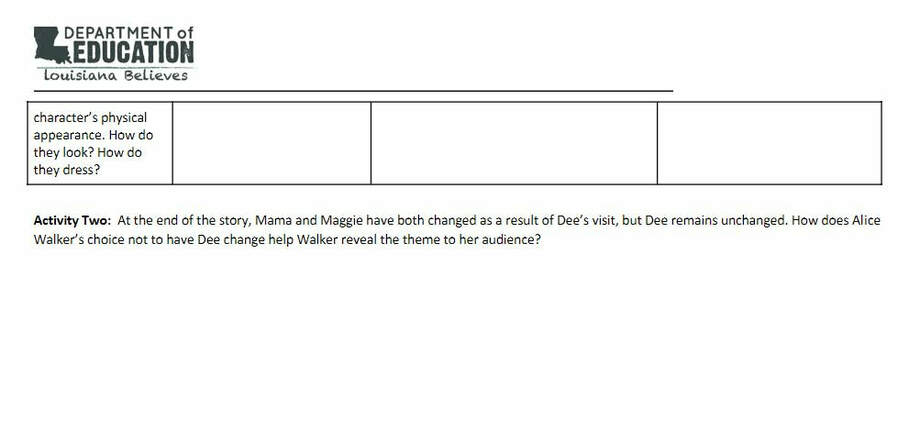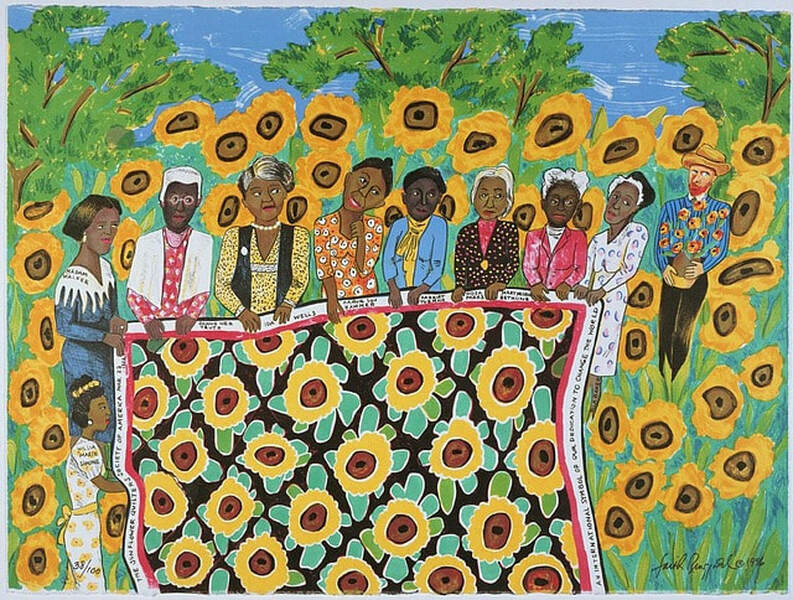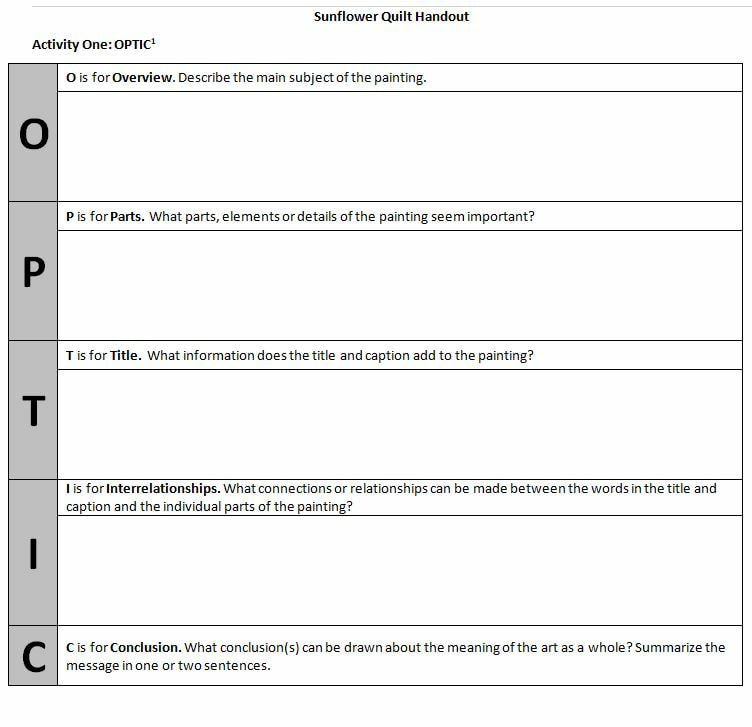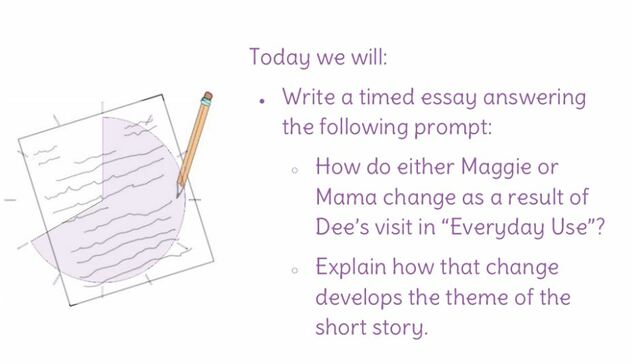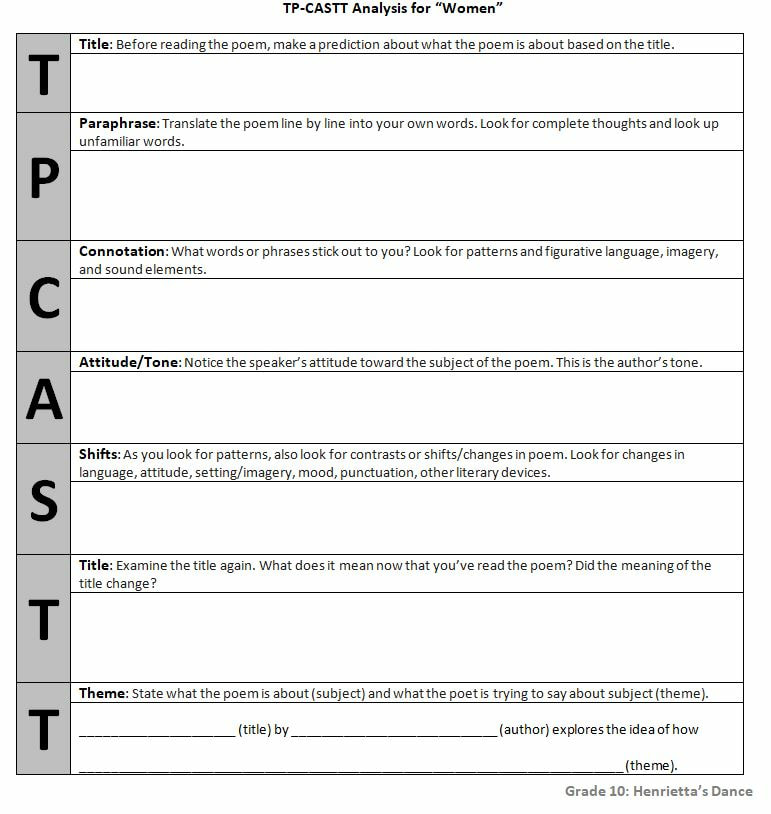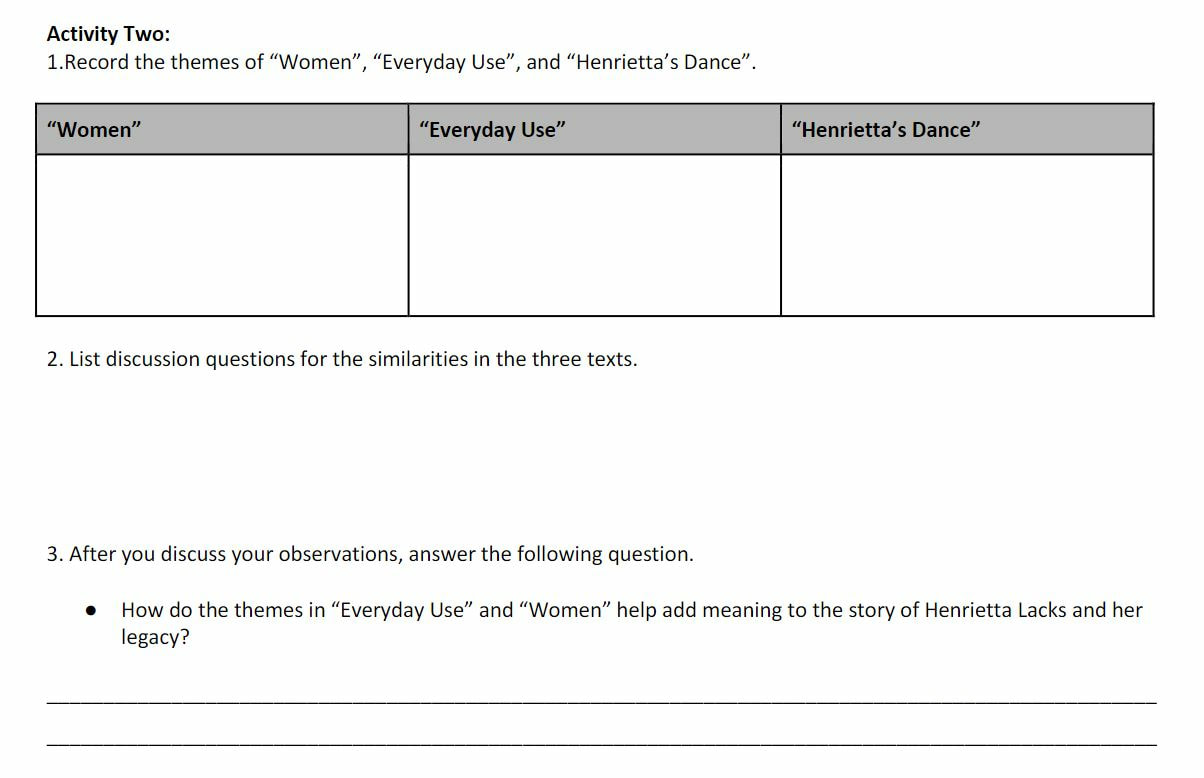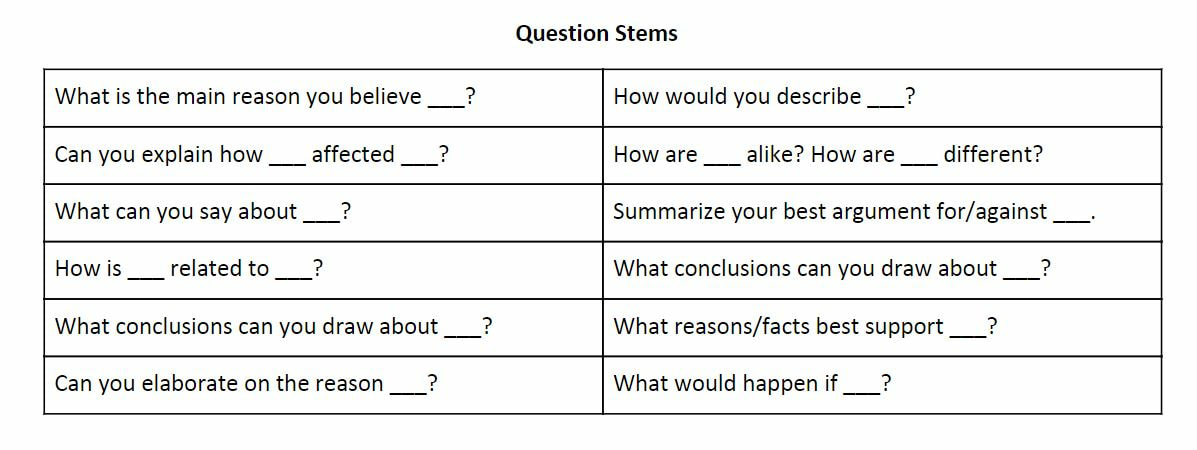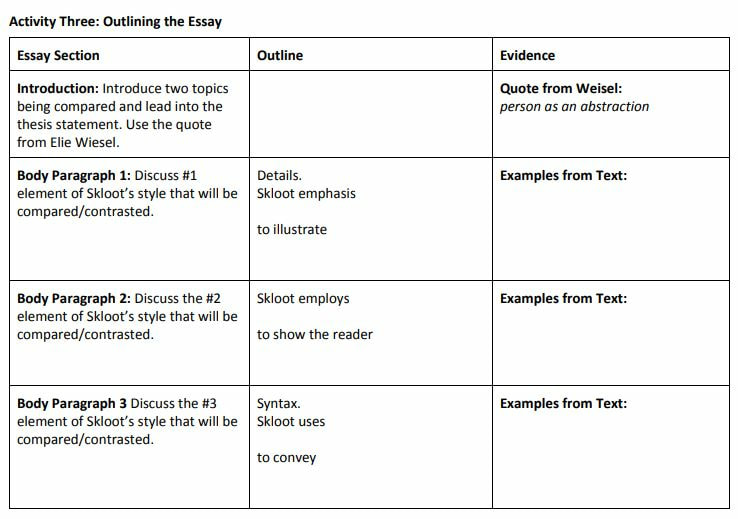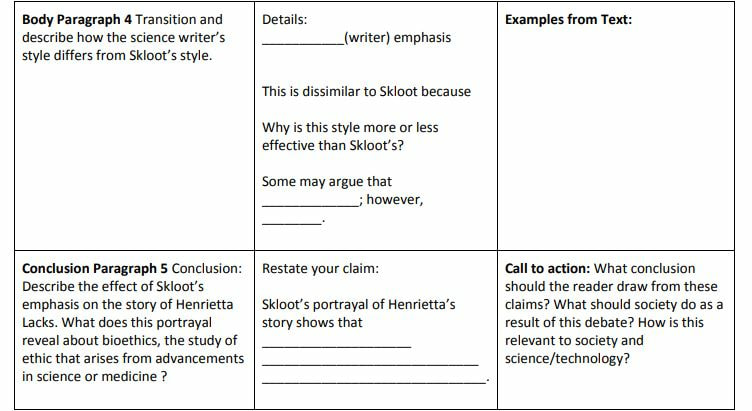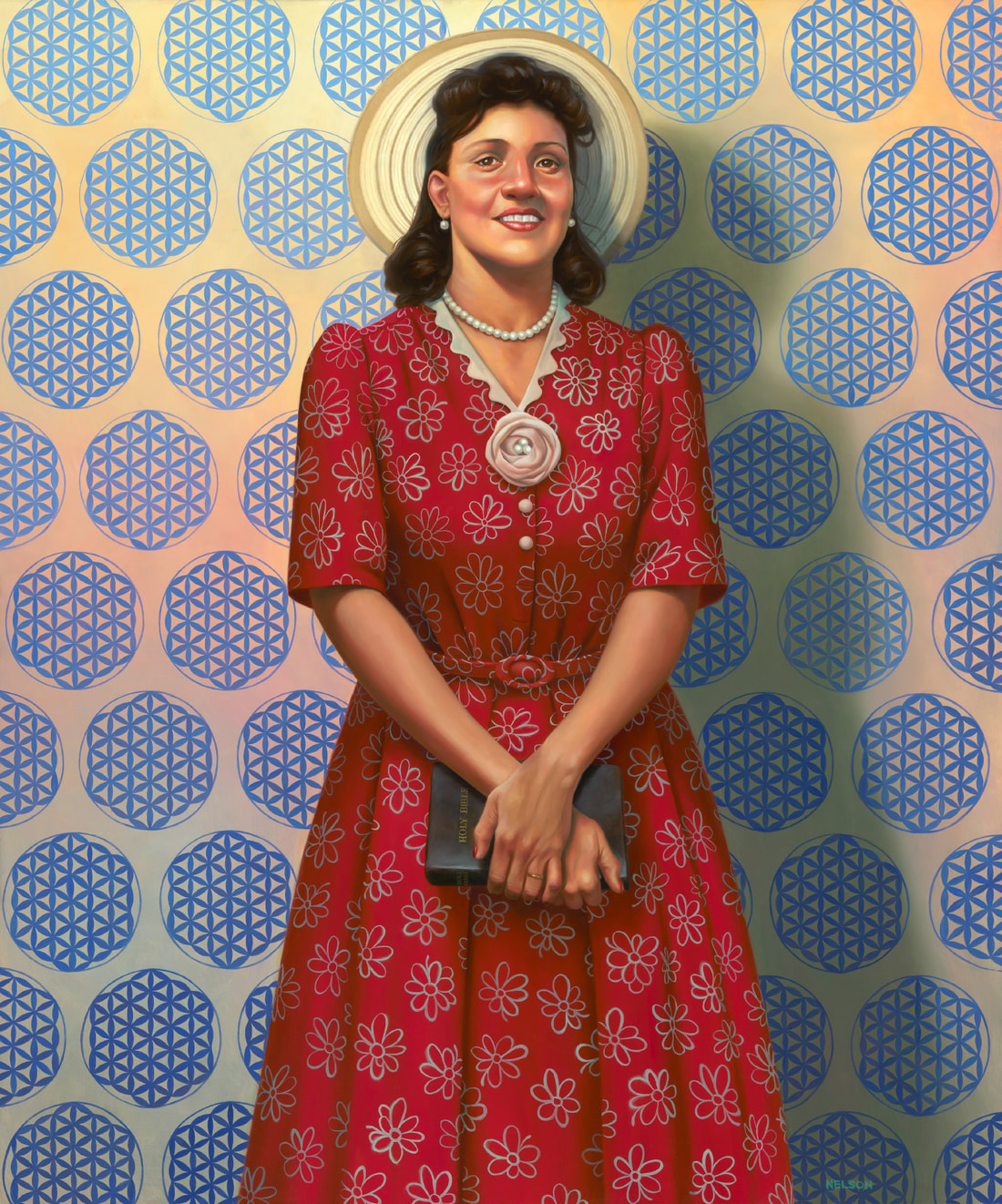page contents
English 2 Learnzillion Assignments:
Objective: Students watch a video of journalist Rebecca Skloot and analyze the image and music to make inferences about the video editor’s purpose.
Lesson 1 Exit Ticket Questions: (Book Trailer Video Clip.)
Respond to the following questions in complete sentences: (5 points each)
1. How does Rebecca Skloot describe people's initial reaction to the book?
2. How does Skloot desribe the reaction of the people who benefited from the cells?
3. How do people's reactions to the book change as Skloot describes it? What causes the change in their reaction?
4. Based on the video, what do you think was Skloot's purpose? Did she want to entertain her readers? Inform them about science? Pursuade them?
Respond to the following questions in complete sentences: (5 points each)
1. How does Rebecca Skloot describe people's initial reaction to the book?
2. How does Skloot desribe the reaction of the people who benefited from the cells?
3. How do people's reactions to the book change as Skloot describes it? What causes the change in their reaction?
4. Based on the video, what do you think was Skloot's purpose? Did she want to entertain her readers? Inform them about science? Pursuade them?
Objective: Students read “Henrietta’s Dance” by Rebecca Skloot and determine how the author develops her claims to advance her purpose.
Lesson 2 Exit Ticket Questions: (Photograph of Henrietta and Day Lacks)
1. What emotions do you notice in Henrietta and David’s eyes? Their mouths?
2. How are the couple posed? What does this tell you about them?
3. What kinds of clothing are they wearing? For what occasion do you think they are dressed?
4. What does the clothing tell you about when the photograph was taken?
5. What do these details tell you about the couple? What assumptions can you make about them?
1. What emotions do you notice in Henrietta and David’s eyes? Their mouths?
2. How are the couple posed? What does this tell you about them?
3. What kinds of clothing are they wearing? For what occasion do you think they are dressed?
4. What does the clothing tell you about when the photograph was taken?
5. What do these details tell you about the couple? What assumptions can you make about them?
Objective: Students analyze “Henrietta’s Dance” to determine elements of Skloot’s style, focusing on diction and imagery.
Lesson 3 Exit Ticket Questions: (for 1-5, Use Dictionary.com)
1. Define Diction.
2. Define Imagery.
3. Define Details.
4. Define Figurative Language.
5. Define Syntax.
6. Are most the words Skloot uses concrete or abstract?Are these words informal or formal?
7. Are these words mostly positive or negative? Why do you think the author chose these words?
1. Define Diction.
2. Define Imagery.
3. Define Details.
4. Define Figurative Language.
5. Define Syntax.
6. Are most the words Skloot uses concrete or abstract?Are these words informal or formal?
7. Are these words mostly positive or negative? Why do you think the author chose these words?
Objective: Students analyze “Henrietta’s Dance” to determine elements of an author’s style, focusing on diction and imagery.
Learnzillion Lesson 4 Exit Ticket Questions:
1. Describe two pieces of information that are repeated or emphasized in Henrietta's Dance.
--
--
What details have been left out?
2. How do the details that Skloot included affect your mood as the reader? Give at least two examples and explain.
--
--
3. (see excerpts)- Identify two forms of figurative language in these quotations.
--
--
4. How does the language choice/diction affect your opinion as the reader?
5. What is the tone of Henrietta's Dance?
6. How does Skloot's role as a journalist affect her tone?
7. Describe Skloot's style: _________________________________ Is her style effective? Why or why not?
1. Describe two pieces of information that are repeated or emphasized in Henrietta's Dance.
--
--
What details have been left out?
2. How do the details that Skloot included affect your mood as the reader? Give at least two examples and explain.
--
--
3. (see excerpts)- Identify two forms of figurative language in these quotations.
--
--
4. How does the language choice/diction affect your opinion as the reader?
5. What is the tone of Henrietta's Dance?
6. How does Skloot's role as a journalist affect her tone?
7. Describe Skloot's style: _________________________________ Is her style effective? Why or why not?
Objective: Students summarize “Immortal Cells, Enduring Issues” by Dale Keiger and practice using context clues and reference materials to determine the meaning of unknown words.
Vocabulary List for "Immortal Cells, Enduring Issues" by Dale Keiger
1. metastasized
2. culture
3. enduring
4. entitled
5. malignancies
6. robust
7. resonated
8. harbors
9. skepticism
10. dovetailed
11. retrospective
12. hamstring
13. repositories
14. onerous
15. decoupled
1. metastasized
2. culture
3. enduring
4. entitled
5. malignancies
6. robust
7. resonated
8. harbors
9. skepticism
10. dovetailed
11. retrospective
12. hamstring
13. repositories
14. onerous
15. decoupled
(Below)- Sample Vocabulary Chart for "Immortal Cells, Enduring Issues" --(For yours, create a blank 5 column by 16 row chart in Google Docs.)
Objective: Students determine and evaluate the claims of “Immortal Cells, Enduring Issues” by Dale Keiger to help them prepare for the Cold Read Task. They may also use this article to write their Culminating Writing Task.
Objective: Students determine the style elements used by Dale Keiger in writing “Immortal Cells, Enduring Issues.” Determining the style of a nonfiction text is part of the Culminating Writing Task; this lesson will help students begin to identify style elements and practice writing about those elements.
Objective: Students analyze photographs and their captions in “Cancer Cells Killed Henrietta Lacks - Then Made Her Immoral” for elements of style and then determine the photographs’ main claims. This lesson connects to the Extension Task as students learn to analyze how an image can support an author’s central idea.
For this assignment, your group may analyze any of the photographs in the series EXCEPT the photograph about the graves (the first one in the sequence.) That one is used as the exemplar.
Objective: Students read “Everyday Use” by Alice Walker and determine the theme of the text by responding to guiding questions and discussion. This text helps students to think about the unit theme of legacy: The importance of leaving a legacy and the myriad of ways that we can leave a legacy, through our language, our families, or even our cells.
In Google Docs, select File: Make a Copy, then edit your own copy from your Google Drive to submit.
Objective: In preparation for the timed writing task, students work to analyze how the characters in “Everyday Use” develop the theme of the text.
Objective: Students analyze the painting, The Sunflower Quilting Bee at Arles by Faith Ringgold, specifically considering the symbolism in the painting. Students then analyze the symbols in “Everyday Use” through discussion and a graphic organizer.
The Sunflower Quilting Bee at Arles by Faith Ringgold
Photo credit:
http://www.faithringgold.com/ringgold/d15.htm
Photo credit:
http://www.faithringgold.com/ringgold/d15.htm
|
Video Clip: Harriet Tubman
|
Video Clip: Rosa Parks
|
Objective: Students complete a timed writing in response answering the prompt: Describe how either Mama or Maggie change as a result of Dee’s visit in “Everyday Use” and explain how this change develops the theme of the short story. This task allows students to express their understanding of the theme of legacy in the unit. It also helps prepare them for the Culminating Writing Task by drafting an essay.
Objective: Students revise their timed writing on how characters’ interactions support the development of a theme in Alice Walker’s “Everyday Use”using a checklist and sentence models.
Submit finished essays to Google Classroom LZ Lesson 15 Assignment: "Everyday Use Timed Essay." Be sure to include your full header on your document. (40 pts.)
Objective: Students read “Women” by Alice Walker and use TP-CASTT to determine a theme of the poem. This will help students prepare for the Cold Read Task in which they will closely analyze a text and determine its theme.
Learnzillion Lesson 16 Exit Ticket Questions:
Objective: Students analyze various accounts of the same subject by comparing the themes of “Everyday Use,” “Women,” and “Henrietta’s Dance.” This will help students prepare for the Cold-Read Task.
Objective: Students read the prologue to The Immortal Life of Henrietta Lacks by Rebecca Skloot and delineate and evaluate the claims in the text. This text will be the one students use for comparison in the Culminating Writing Task.
Objective: Students determine the elements of style used in the prologue of The Immortal Life of Henrietta Lacks by Rebecca Skloot in preparation for the Culminating Writing Task, which asks them to compare Skloot’s style to another author’s style.
Objective: In preparation for the cold read task, students practice determining the meaning of unknown words in the text “Immortal Cells, Moral Issues” by Ruth Faden and independently summarize the claims in that text.
Text Vocabulary Asssessment: After you've practiced the set using the learning tools in Quizlet (match games, flash cards, etc.) Create a test under your own account (login with school Google Credentials). The test must be set up in the Options section with Matching/M/C, and T/F only, with all possible questions included (15 of 15 questions). ACE IT, and show me your score to get your points for this assignment. You must have full mastery (100%) on your quiz to get all of your points! (30 points total). I will enter your score in Google Classroom as well if you select "Mark as Done" when you are finished with the assignment.
Objective: In preparation for the Culminating Writing Task, students determine the style of “Immortal Cells, Moral Issues” by Ruth Faden, and then through discussion, evaluate whether Faden or Skloot’s style is more effective.
Objective: Students read “Henrietta Lacks’ ‘Immortal’ Cells” by Sarah Zielinski and practice answering assessment items. The essay portion will be completed in the next lesson.
The Part that's missing from the text in the blue books:
Pg 29
And for the rest of us?
The story of HeLa cells and what happened with Henrietta has often been held up as an example of a racist white scientist doing something malicious to a black woman. But that’s not accurate. The real story is much more subtle and complicated. What is very true about science is that there are human beings behind it and sometimes even with the best of intentions things go wrong.
One of the things I don’t want people to take from the story is the idea that tissue culture is bad. So much of medicine today depends on tissue culture. HIV tests, many basic drugs, all of our vaccines—we would have none of that if it wasn’t for scientists collecting cells from people and growing them. And the need for these cells is going to get greater, not less. Instead of saying we don’t want that to happen, we just need to look at how it can happen in a way that everyone is OK with.
Pg 29
And for the rest of us?
The story of HeLa cells and what happened with Henrietta has often been held up as an example of a racist white scientist doing something malicious to a black woman. But that’s not accurate. The real story is much more subtle and complicated. What is very true about science is that there are human beings behind it and sometimes even with the best of intentions things go wrong.
One of the things I don’t want people to take from the story is the idea that tissue culture is bad. So much of medicine today depends on tissue culture. HIV tests, many basic drugs, all of our vaccines—we would have none of that if it wasn’t for scientists collecting cells from people and growing them. And the need for these cells is going to get greater, not less. Instead of saying we don’t want that to happen, we just need to look at how it can happen in a way that everyone is OK with.
Objective: Practice a Timed Writing on a Nonfiction Text.
Objective: Analyze the culminating writing prompt and write your main claim.
Culminating Writing Task Directions:
“We must not see any person as an abstraction. Instead, we must see in every person a universe with its own secrets, with its own treasures, with its own sources of anguish, and with some measure of triumph.” --Elie Wiesel from The Nazi Doctors and the Nuremberg Code
LZ Lesson 28 Exit Ticket Questions
Activity One:
Analyze the prompt Evaluate the effectiveness of Skloot’s style in portraying the story of HeLa cells as being as much about the people as it is about the science. Write an essay that compares and contrasts the way Rebecca Skloot tells Henrietta’s story with how others in the scientific community or media have portrayed Henrietta and her situation.
What details are emphasized in various accounts? Use proper grammar, conventions, spelling, and grade-appropriate words and phrases. Cite several pieces of textual evidence to support your argument and analysis.
1. What kind of prompt is this?
2. The prompt asks you to discuss details. Which other two elements of style do you want to write about?
❏ Diction ❏ Imagery ❏ Language ❏ Syntax ❏ Tone
2. (b) Why did you choose these elements of style?
3. Which science writer do you want to compare and contrast with Skloot?
❏ Rebecca Faden, “Immortal Cells, Moral Issues”
❏ Dale Keiger, “Immortal Cells, Enduring Issues”
❏ Robert D. Truog,, et. al, “Paying Patients for Their Tissues
❏ Sarah Zielinski, “Henrietta Lacks’ Immortal Cells”
4. (b) Why did you choose that text?
“We must not see any person as an abstraction. Instead, we must see in every person a universe with its own secrets, with its own treasures, with its own sources of anguish, and with some measure of triumph.” --Elie Wiesel from The Nazi Doctors and the Nuremberg Code
LZ Lesson 28 Exit Ticket Questions
Activity One:
Analyze the prompt Evaluate the effectiveness of Skloot’s style in portraying the story of HeLa cells as being as much about the people as it is about the science. Write an essay that compares and contrasts the way Rebecca Skloot tells Henrietta’s story with how others in the scientific community or media have portrayed Henrietta and her situation.
What details are emphasized in various accounts? Use proper grammar, conventions, spelling, and grade-appropriate words and phrases. Cite several pieces of textual evidence to support your argument and analysis.
1. What kind of prompt is this?
2. The prompt asks you to discuss details. Which other two elements of style do you want to write about?
❏ Diction ❏ Imagery ❏ Language ❏ Syntax ❏ Tone
2. (b) Why did you choose these elements of style?
3. Which science writer do you want to compare and contrast with Skloot?
❏ Rebecca Faden, “Immortal Cells, Moral Issues”
❏ Dale Keiger, “Immortal Cells, Enduring Issues”
❏ Robert D. Truog,, et. al, “Paying Patients for Their Tissues
❏ Sarah Zielinski, “Henrietta Lacks’ Immortal Cells”
4. (b) Why did you choose that text?
Objective: Students outline their culminating writing task essay and write a rough draft in response to the prompt: “Evaluate the effectiveness of Skloot’s style in portraying the story of HeLa cells as being as much about the people as it is about the science.”
LZ Lesson 29 Exit Ticket Question:
Activity Two:
Claim Paragraph
Although science writers Rebecca Skloot and _______________________________ both ______________(strong verb) ________________________________________________ (central idea), Skloot’s _________________ (adjective) style is more effective. She uses __________________________ (describe element of style), ___________________________ (describe element of style) and ______________________________ (describe element of style) in order to ___________ ________________________________________________________________________________________________ __.
Activity Two:
Claim Paragraph
Although science writers Rebecca Skloot and _______________________________ both ______________(strong verb) ________________________________________________ (central idea), Skloot’s _________________ (adjective) style is more effective. She uses __________________________ (describe element of style), ___________________________ (describe element of style) and ______________________________ (describe element of style) in order to ___________ ________________________________________________________________________________________________ __.
Objective: Students continue the writing process by writing a first draft to the prompt: “Evaluate the effectiveness of Skloot’s style in portraying the story of HeLa cells as being as much about the people as it is about the science.”
Objective: Students will revise and publish their argumentative essays that compare and contrast Rebecca Skloot’s style with other’s in the scientific community.
Upload revised essays with a full heading to Google Classroom assignment titled "LZ Lesson 31: Henrietta's Dance: Culminating Writing Task." All textual evidence should be cited appropriately using MLA format in-text citations.
Objective: Students express understanding of nonfiction texts by reading a nonfiction text, viewing a video, and answering multiple selection questions.
(Substitute district-approved Commonlit Cold Read Assessment for grade book Learnzillion Lesson 32,33-assigned through Google Classroom)
Objective: Students respond to the essay portion of the cold-read task to express understanding of a nonfiction text. Students may use the remaining time to work on their multimedia presentations.
Speech 2 Learnzillion Assignments: Henrietta's Dance Unit
Research Questions Learnzillion Lesson 5 Exit Ticket:
Extension Task Instructions
My Research Disease or Condition _________________________
Analyze the Prompt
Select a disease from the list generated by your teacher and research the following:
1. The history of the disease or condition.
2. Changing theories surrounding the disease/condition (e.g., causes, cures)
3. Innovators who’ve made a difference in its diagnosis, treatment, cure, or eradication.
4. How the disease or condition has impacted humanity (e.g. political, cultural, or economic) and/or stories of people who have
suffered with the disease.
5.Underline the information that must be included in your project.
6.Where will you look for information?
7. What is/are the available mode(s) for reporting your findings?
8. What is/are the possible modes for my presentation?
Extension Task Prompt:
Create a brief written proposal for investigating and presenting information about the disease. Thoroughly research
that disease and report your findings, along with citations, to your teacher and/or classmates using technology. Then
use technology to produce and publish your presentation, taking advantage of technology’s capacity to link to other
information and to display information flexibly and dynamically.
Extension Task Instructions
My Research Disease or Condition _________________________
Analyze the Prompt
Select a disease from the list generated by your teacher and research the following:
1. The history of the disease or condition.
2. Changing theories surrounding the disease/condition (e.g., causes, cures)
3. Innovators who’ve made a difference in its diagnosis, treatment, cure, or eradication.
4. How the disease or condition has impacted humanity (e.g. political, cultural, or economic) and/or stories of people who have
suffered with the disease.
5.Underline the information that must be included in your project.
6.Where will you look for information?
7. What is/are the available mode(s) for reporting your findings?
8. What is/are the possible modes for my presentation?
Extension Task Prompt:
Create a brief written proposal for investigating and presenting information about the disease. Thoroughly research
that disease and report your findings, along with citations, to your teacher and/or classmates using technology. Then
use technology to produce and publish your presentation, taking advantage of technology’s capacity to link to other
information and to display information flexibly and dynamically.
Online Research Resources:
(Usernames and Passwords for Gale Group and World Book Online are on the marker board in the classroom.) Write them down or add them to your Research Handout for reference later at home.
Objective: Students begin gathering research about their disease, write a reflection about their research, and publish their reflection on a district-approved mode, such as a blog, wiki, or e-mail.
Objective: Students continue to gather research about their selected disease, write a reflection about their research, and publish their reflection on a district-approved mode, such as a blog, wiki, or e-mail.
Objective: Students use digital media databases to gather multimedia to illustrate the research that they gathered in previous lessons in preparation for drafting their multimedia project.
Objective: Students read “Paying Patients for Their Tissues” by Robert D. Truog, et. al and prepare for a digital collaborative discussion by writing questions to synthesize knowledge of critical issues in the unit.
Objective: Students prepare answers to discussion questions and then conduct a discussion on whether patients should be paid for tissue.
Socratic Seminar Question:
Should patients be compensated financially for the tissues that they donate for research?
Should patients donate tissues for the common good, the expectation that all of humanity will
benefit from the research? Be prepared to discuss these ideas, citing evidence from texts we’ve read in this class.
Conversation Stems for Class Discussion
1. As you engage in class discussion, it is important to consider the other side, expressing understanding for those who
have a different point of view. To do this, you can insert a concession in your comments. You can
also use the templates in the chart to help frame your answers.
Concession Stems
●Although I grant that __, I still maintain that __.
●While it is true that __, it does not necessarily follow that __.
●On one hand I agree with X that __. But on the other hand, I insist that __.
●It cannot be denied that __; however, I believe__.
●Certainly __, but ....
●It goes without saying...
●Perhaps __, yet....
Should patients be compensated financially for the tissues that they donate for research?
Should patients donate tissues for the common good, the expectation that all of humanity will
benefit from the research? Be prepared to discuss these ideas, citing evidence from texts we’ve read in this class.
Conversation Stems for Class Discussion
1. As you engage in class discussion, it is important to consider the other side, expressing understanding for those who
have a different point of view. To do this, you can insert a concession in your comments. You can
also use the templates in the chart to help frame your answers.
Concession Stems
●Although I grant that __, I still maintain that __.
●While it is true that __, it does not necessarily follow that __.
●On one hand I agree with X that __. But on the other hand, I insist that __.
●It cannot be denied that __; however, I believe__.
●Certainly __, but ....
●It goes without saying...
●Perhaps __, yet....
Objective: Students create a storyboard to plan out their multimedia project on their research of a particular disease.
Objective: Students create their multimedia project on their research of a particular disease using their storyboard and notes.
Objective: Students evaluate a peer’s multimedia project and revise their multimedia project using peer feedback.
Objective: Students share their multimedia projects with peers and will receive and provide feedback on their finished projects.
HENRIETTA LACKS PAINTING
|
Image Source: Smithsonian National Portrait Gallery and National Museum of African American History and Culture
The full portrait of Henrietta Lacks in the National Portrait Gallery.Henrietta Lacks’s life ended abruptly and painfully. In 1951, at the age of 31, Lacks died in Baltimore, Maryland from an aggressive form of cervical cancer. But her legacy, in the form of a cell line derived from her cancer cells have lived on literally ever since. While Lacks was seeking treatment at Johns Hopkins University in Baltimore, her doctors scraped away some of the cells from her tumor and kept them alive and thriving in petri dishes. No other human cells had been able to survive and replicate outside the body at that point in time, which had severely limited scientific research. What came to be called the “HeLa” cell line was essential in the breakthroughs that led to the polio vaccine, as well advances in HIV and cancer treatments. Now there’s another addition to the Lacks legacy. On Monday (May 14) the Smithsonian National Portrait Gallery unveiled a painting of Lacks, the newest addition to its collection. The Portrait Gallery and National Museum of African American Art and Culture’s joint purchase of the Lacks painting is just the latest in a series of recent events that have sought to right the wrongs many feel were done to Lacks and her family. But this is also one of the only of those efforts that has make the Lacks family feel Henrietta is getting recognized in the right way. Though many scientists—and the world more generally—have benefitted from Lacks’s cell line, but neither she nor her family ever gave permission for her tissue to be used in a lab setting. In fact, it wasn’t until 1975 when a family friend serendipitously asked a colleague about the history of the HeLa line when the family realized these cells had been taken at all. Lacks’s stolen cells are far from the only first instance of racism in scientific research. Just a few years before Lacks visited her first physicians was the start of the now-infamous Tuskegee syphilis experiments, in which federal US researchers infected hundreds of African American men with syphilis and lied about giving them treatment in order to see the full effects of the disease’s progression. Last year, the Lawrence Lacks, Henrietta’s son, unsuccessfully sought compensation from Johns Hopkins for Henrietta’s contributions to public health. The university claims that because it never patented the cells, it never profited from them. HeLa cells have been publicly available—though that has been somewhat limited since 2013, when the US National Institutes of Health created a review panel, which includes two Lacks family members, for all research proposals involving the cell line. Previous attempts to depict Henrietta’s story have disappointed the family, as well. Lawrence complained to the Baltimore Sun that neither The Immortal Life of Henrietta Lacks by Rebecca Skloot nor the HBO adaptation starring Oprah Winfrey did do justice to his mother’s life. |
But seeing the Lacks’s saintly portrait hanging on a prominent wall at the gallery in Washington thrilled Lacks family.
HBO commissioned the portrait in conjunction with the promotion of the 2017 film. An HBO spokesperson tells Quartz that the painting was created “with a larger goal in mind to ensure her legacy lived on” after the film premiered. HBO selected an artist with an acuity for storytelling. Los Angeles-based painter Kadir Nelson is also the author of several best-selling children’s books on African-American culture and worked as the lead artist for Steven Spielberg’s 1997 historical drama Amistad. The 44-year old artist uses tropes drawn from allegorical religious portraiture to summarize the biography of the so-called “Mother of Modern Medicine.” “She stands with her beautifully manicured hands crossed, covering her womb (the birthplace of the immortal cell line) while cradling her beloved Bible (a symbol of her strong faith). Her deep red dress is covered with a vibrant floral pattern that recalls images of cell structure and division,” Nelson writes in an Instagram post. “Her bright yellow hat, which functions as a halo, her pearls as a symbol of the cancer that took her life, and the repeated hexagonal wallpaper pattern, a design containing the ‘Flower of Life,’ an ancient symbol of immortality and exponential growth.” But the portrait’s most essential detail is one Nelson purposely omitted. Missing from her crimson dress are several buttons that allude to the cells harvested from Lacks’s body. https://instagram.com/p/BimrBjCBpPz/In the portrait, Lacks is depicted wearing pearls. That’s a reference to her illness—according to doctor reports at the time, Henrietta’s tumor looked like pearls. But they can be interpreted through all sorts of different lenses. “Pearls seem like it’s classy, just a test of time—and that’s what she was, she was classy,” Kimberly Lacks, Henrietta’s granddaughter, told NPR. “I just think it’s amazing. A great representation of our grandmother.” Reference: https://nmaahc.si.edu/about/news/national-portrait-gallery-presents-portrait-henrietta-lacks-co-acquisition-national By Katherine Ellen Foley & Anne Quito May 18, 2018 |
CCSS Standards addressed in this unit:
CCSS.ELA-LITERACY.W.9-10.2
Write informative/explanatory texts to examine and convey complex ideas, concepts, and information clearly and accurately through the effective selection, organization, and analysis of content.
CCSS.ELA-LITERACY.W.9-10.2.A
Introduce a topic; organize complex ideas, concepts, and information to make important connections and distinctions; include formatting (e.g., headings), graphics (e.g., figures, tables), and multimedia when useful to aiding comprehension.
CCSS.ELA-LITERACY.W.9-10.2.B
Develop the topic with well-chosen, relevant, and sufficient facts, extended definitions, concrete details, quotations, or other information and examples appropriate to the audience's knowledge of the topic.
CCSS.ELA-LITERACY.W.9-10.2.C
Use appropriate and varied transitions to link the major sections of the text, create cohesion, and clarify the relationships among complex ideas and concepts.
CCSS.ELA-LITERACY.W.9-10.2.D
Use precise language and domain-specific vocabulary to manage the complexity of the topic.
CCSS.ELA-LITERACY.W.9-10.2.E
Establish and maintain a formal style and objective tone while attending to the norms and conventions of the discipline in which they are writing.
CCSS.ELA-LITERACY.W.9-10.2.F
Provide a concluding statement or section that follows from and supports the information or explanation presented (e.g., articulating implications or the significance of the topic).
CCSS.ELA-LITERACY.W.9-10.2
Write informative/explanatory texts to examine and convey complex ideas, concepts, and information clearly and accurately through the effective selection, organization, and analysis of content.
CCSS.ELA-LITERACY.W.9-10.2.A
Introduce a topic; organize complex ideas, concepts, and information to make important connections and distinctions; include formatting (e.g., headings), graphics (e.g., figures, tables), and multimedia when useful to aiding comprehension.
CCSS.ELA-LITERACY.W.9-10.2.B
Develop the topic with well-chosen, relevant, and sufficient facts, extended definitions, concrete details, quotations, or other information and examples appropriate to the audience's knowledge of the topic.
CCSS.ELA-LITERACY.W.9-10.2.C
Use appropriate and varied transitions to link the major sections of the text, create cohesion, and clarify the relationships among complex ideas and concepts.
CCSS.ELA-LITERACY.W.9-10.2.D
Use precise language and domain-specific vocabulary to manage the complexity of the topic.
CCSS.ELA-LITERACY.W.9-10.2.E
Establish and maintain a formal style and objective tone while attending to the norms and conventions of the discipline in which they are writing.
CCSS.ELA-LITERACY.W.9-10.2.F
Provide a concluding statement or section that follows from and supports the information or explanation presented (e.g., articulating implications or the significance of the topic).
